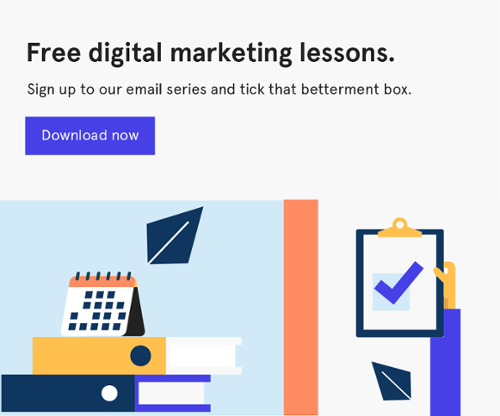Personalisation in marketing works because personal connections matter. That extends beyond your customers, too. Personal connections include the relationships you have with your suppliers, your stakeholders, your employees, industry peers… the list goes on.
Want to grow your network? Build your community.
Doing so takes time and patience. Networking (or as we prefer to think of it, community building) is an iterative activity that you optimise over a period. It’s not a project with a beginning, middle and end — it’s more organic than that. Make a connection, grow, learn, make another connection, on and on.
Over time, you’ll turn competitors into partners; bigger companies into backup; hungry start-ups into think tanks, and even causes into sponsorships. As you do this, you’ll discover new opportunities and will become more known in your sector.
So, make your business a friend worth having. You never know where your next referral is going to come from. It could be from the person you gave a nugget of helpful advice to at an event. It could be because someone sees you’re leading the charge towards Net Zero, or you’re the first company in your region to become B Corp. There are companies who are on that same journey. They will want to learn from you, connect with you, buy from you and collaborate with you.
Community AS branding
As an example, those of you who operate in the Environmental Tech sector know this all too well: how much building that sense of community is a part of your brand. ‘We are all in this together, doing our bit to save the planet.’ If one business is serious about sustainability, it will partner with organisations that are on the same wavelength. The attitude of collective participation is an important part of the brand.
No person is an island; no business is either. Organisations that have a clear mission, that have a company culture and values that people want to be aligned with, that do great work and contribute valuable insights to the conversation freely and generously — these are the organisations, the people, with whom others want to associate. That is the direction forward-thinking businesses are going in. In short: ‘The currency of real networking is not greed, but generosity.’ So says Keith Ferrazzi, New York Times best-selling author.
Mutually assured benefits
Yes, sure, when it comes to marketing, you want to capitalise on your relationship with another organisation, accessing their audience to grow your own. You want new ways of doing things and insider secrets. You want to learn from others and benefit from their experience. You want to use connections to build your reputation. You want to sell to potential buyers. Want want want.
As they say in New York, everybody wants something.
What is crucial, however, is the give and take. You have to have enough credibility in the space and enough of an audience that other companies are keen to partner with you. You have to have something to give. Information, contacts, experience, skills, ideas, help.
This all sounds a bit transactional, but there is a word for that, and it sits at the heart of most communities: the marketplace. Not that one. More, your local farmer’s market. There’s a lot to learn from such places. Local marketplaces are not just about the sale; they’re about coming together as a community, growing together, meeting people and giving back to the local economy. Embody the spirit of free samples and getting to know your fellow vendors. You can’t go wrong.
If you still don’t know where to begin — beyond shaking hands and exchanging never-to-be-read business cards at a conference — here are two ways to kick-start this process:
1. Co-branded campaigns
Run a joint marketing campaign with another organisation. This gets your marketing in front of a new audience and means you can pool resources, benefitting from economies of scale.
An example. Data storage and management company A joins forces with Cybersecurity business B. Together, they decide to run a marketing campaign on ‘business continuity’ featuring voices from both sides. Not only does this give their audiences a deeper, more nuanced understanding of the subject matter, but it lends more authority to the campaign overall. They both benefit from the reputation of the other, and can even refer business to one another after the fact.
And, it’s an easy pitch. Offer your point of contact at another business the chance to do a co-branded marketing campaign on a subject that benefits them too, and offer to pay for half of it. Watch them leap at the opportunity.
2. Be my guest
Another tactic is to be a guest on a webinar, podcast, video or event, sharing your wisdom as a thought leader. It’s estimated there are between three and four million podcasts out there. Many will welcome business leaders onto their platforms. And, you can use your own platform, whether that’s a podcast or webinar or whatever, to feature guests in turn. This is reciprocity at its finest.
Plus, it’s highly scalable. Start with being a guest and freely providing information, then invite guests back to your platform, which you’ve created in the meantime by working out what resonates with people. As you get out there, build your repertoire of useful and valuable ideas. You’ve attended many a conference, but perhaps now is the moment to sign up to speak at your next favourite industry event. Maybe one day, you’ll be running the conferences. And, like that magnetic person at any event, you’ll be the hub of attention, energy — and commerce.
Customer advocacy
‘Advocacy can propel a brand unlike any other paid or unpaid media because it unlocks the networking power of one-to-one relationships with a key of trust.’
— Rick Wion, Senior Director of Consumer Engagement, The Kellogg Company
How can you tell if your differentiation strategy is working? More leads, more customers. Sure. Brand recognition. Of course. Engagement. Yeah. But customer advocacy is the gold standard. Where engagement is conversation, advocacy is creed. It’s buy-in. It’s loyalty, faith, internalisation, fervour, love. It’s seeing oneself as the extension of a brand, and as its champion and defendant. It’s vouching for a business, even in times of crisis. It’s the ultimate achievement — the glorious moment when your customer starts doing your marketing for you.
The shining stars of your network are such advocates. Here is how you can gain customer advocacy:
1. Create referral scheme
First up is the obvious one. Get referrals. Every business wants referrals. Asking, often, isn’t enough. You need to optimise your chance at getting referrals by implementing a referral scheme. Give existing customers discounted rates or a percentage finder’s fee for referring new business. Promote your referral scheme, such as by using segmentation to surface it as a pop-up or CTA on your website to customers, or through a customer newsletter or portal.
2. Enablement
Alternatively, take a leaf out of the book of vendors. Tech vendors, like Microsoft, are experts at enabling their partners to do marketing on their behalf. Like a co-branded campaign, you can give customers the marketing collateral to share with others as a nicely bundled package. Again, you could offer incentives for doing so. Ideally, you won’t have to. You’re simply helping customers to articulate this message: ‘Check out this business that we work with, don’t you think they’d be a great fit for what you’re trying to achieve, too?’
3. Awards
There are plenty of awarding bodies for businesses, both for the work they do and for things like culture. Awards are like case studies, except the audience is a panel of judges, all of whom are authorities in your industry. Businesses that win awards certainly stand out. And customers who are true advocates would be delighted to either support an award entry or even nominate you for an award themselves. We’ve seen it happen.
No business is an island
Humans are social creatures. It’s what sets us apart from the baser creatures, right? Our ability to build deeper, more widespread, meaningful relationships as we thrive, together. Sometimes, standing out means fitting in, gaining trust and trusting others in turn.
 Posted by
Maddy Leslie
Posted by
Maddy Leslie





